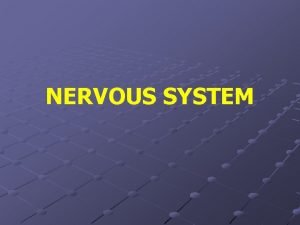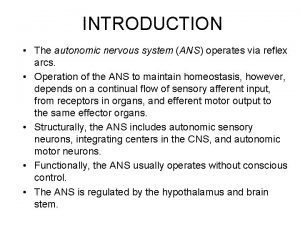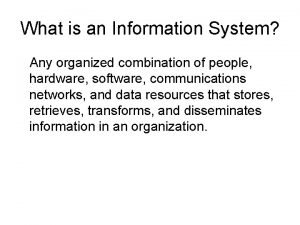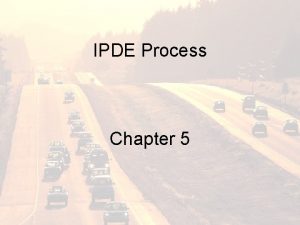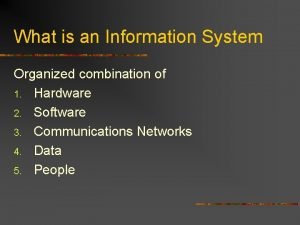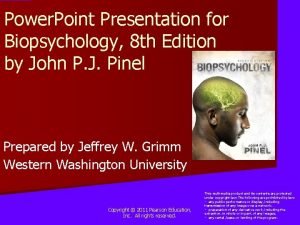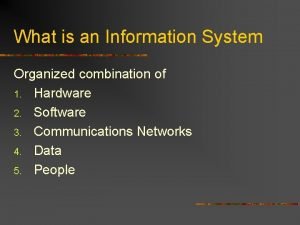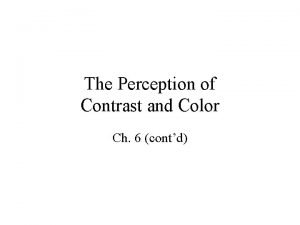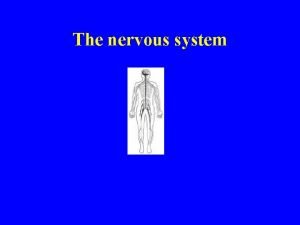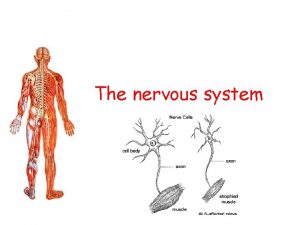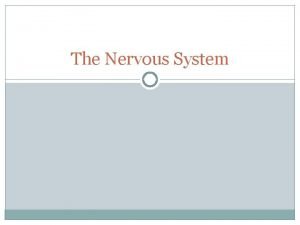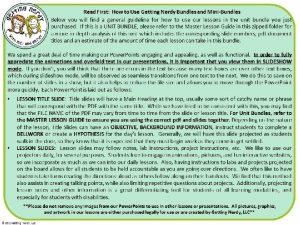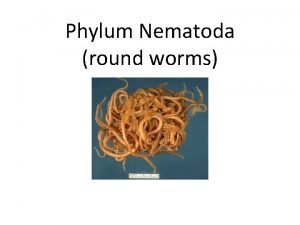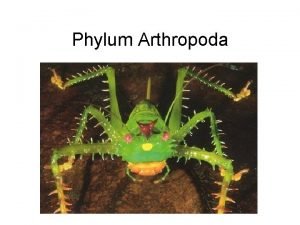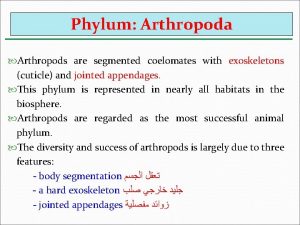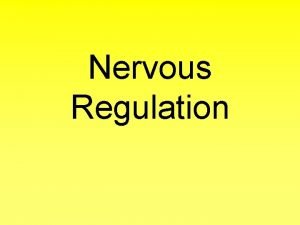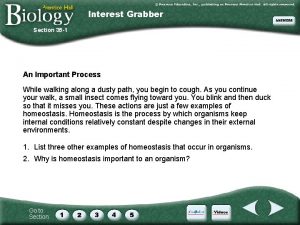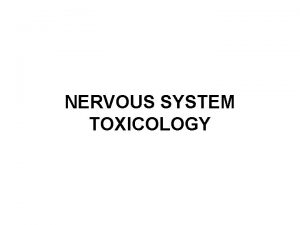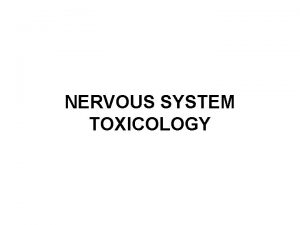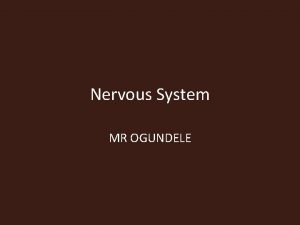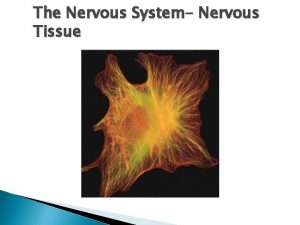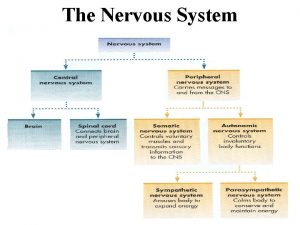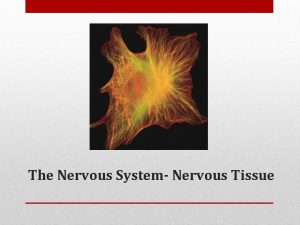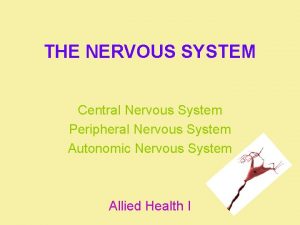NERVOUS SYSTEM Introduction n Most highly organized system








































- Slides: 40

NERVOUS SYSTEM

Introduction n Most highly organized system of the body Fast, complex communication system that regulates thoughts, emotions, movements, impressions, reasoning, learning, memory, choices Basic Characteristics Master control system Master communication system Regulates, maintains homeostasis

Major Structures and Divisions n n n Central nervous system (CNS) Peripheral nervous system (PNS) Automatic Nervous System

Functions Monitors change (stimuli) sensory input Integrates impulses integration Effects responses motor output

Histology of Nervous Tissue Basic Characteristics Highly cellular 2 types of cells - neurons and supporting cells (neuroglia)

Neuroglia Characteristics Dense network of supporting cells for nerve tissue Over 900 billion CAN replace themselves Also known as glia cells (glia = glue) Supportive scaffolding; insulation; neuron health and growth (act as “glue” to support, bind, repair, and protect neurons)

Neurons: Basic Characteristics Over 100 billion Highly specialized Conduct messages in form of nerve impulses Extreme longevity (>100 years) High metabolic rate 3 functional components in common: receptive/input regions, conducting component/trigger zone, secretory/output component Three types n n n A = afferent (sensory) C = Connective (associative) E = Efferent (motor)

Neurons: Characteristics Excitability: the ability to react to a stimuli, physical or chemical Irritability: sensory adaptation, with prolonged stimulation, irritability is temporarily lost (i. e. smell) Conductivity: the ability to transmit an impulse n n Nonmyelinated fibers = 0. 5 - 1 meter /sec (1 mph) Myelinated fibers = 80 - 130 meters/sec (300 mph)

The Hand as a Neuron

A Closer Look: Parts of a Neuron nucleus soma dendrites axon myelin sheath terminal axon

Myelin Sheath Whitish, fatty (protein lipoid) segmented covering of axons Myelinated fibers: conduct nerve impulses rapidly; electrical insulation Unmyelinated fibers: conduct impulses slowly White matter: myelinated sheaths around axons of the PNS gives the tissue a white color and forms myelinated nerves (axons = myelinated tracts) Gray matter: concentrations of cell bodies and unmyelinated fibers ( in PNS = ganglia; in CNS = nuclei)

Neurophysiology—Chemical Events At the Synapse

The Synapse the dynamic region between an axon terminal and a receiving neuron space between a terminal axon and receiving neuron is called the synaptic cleft is where electrochemical transmission takes place, thus communication Impulses from one neuron are transmitted across the synapse to another neuron by a chemical called a neurotransmitter

Vesicles release Neurotransmitters synapse 4

Inactivation of Neurotransmitters The action of neurotransmitters can be stopped by four different mechanisms: 1. Diffusion – neurotransmitters drifts away out of synaptic cleft 2. Enzyme deactivation – specific enzyme changes structure of neurotransmitter so it is not recognized by receptor

Inactivation of Neurotransmitters continued 3. Glia cells – astrocytes remove neurotransmitters from synaptic cleft 4. Reuptake – whole neurotransmitter molecule is taken back into axon terminal that released it

Some of the Better Known Neurotransmitters

Acetycholine Contributes to movement, learning, memory processes, and REM sleep Only transmitter between motor neurons and voluntary muscles EXCESS: muscle paralysis or convulsions, sometimes death DEFICIT: memory impairment (Alzheimer’s disease)

Dopamine Used by neurons that control voluntary movements Also used by neurons that are important for learning, attention, thought & emotion EXCESS: irrational thought, delusion, and/or hallucinations (Schizophrenia) DEFICIT: tremors, muscular rigidity, (Parkinson’s disease)

Serotonin plays prominent role in regulation of mood, sleep, impulsivity, aggression, and appetite DEFICIT: related to depression, aggressive behavior

Norepinephrine Plays a role in eating, sleep, and mood DEFICIT: related to depression

Gamma-Aminobutyric Acid (GABA) Appears to have inhibitory effects at synapses Contributes to regulation of anxiety & levels of activity ABNORMALITY in GABA may cause epilepsy

Endorphins Opiate-like substances produced in the body Provide relief from pain and produce feelings of pleasure & well-being Drugs such as opium, morphine, and heroin bind with receptors for endorphins Endorphins may explain “runner’s high” experienced by long-distance runners

Divisions of the Nervous System

Central Nervous System – Brain and the Spinal Cord Integrates incoming pieces of sensory information, evaluates the information, and initiates the outgoing responses NO potential for regeneration

Brain Largest structure of the nervous system and one of the largest organs of the body n n n 12 billion neurons and neuroglia The adult human brain weighs between 1300 g and 1400 g (approximately 3 lbs). A newborn human brain weighs between 350 and 400 g. For comparison: elephant brain = 6, 000 g chimpanzee brain = 420 g rhesus monkey brain = 95 g beagle dog brain = 72 g cat brain = 30 g rat brain = 2 g

Brain Covered by three layers of membranes called meninges n n n Dura mater Arachnoid Pia mater

Structure of the Brain

Cerebrum Largest mass of brain (83% of brain mass); uppermost and least protective layer of the brain; responsible for higher mental functions and distribution of impulses Cerebral cortex: outer layer of gray matter; short and long term memory Cerebral medulla: white matter, conduction pathways Divided into right and left hemispheres (left side governs right side of body, right side governs left side of body) Two hemispheres connected by the corpus callosum Each hemisphere has four lobes Middle regions of the cerebrum are canals, called ventricles

Right vs. Left Hemisphere Left side processes: • Speech • Analysis • Time • Sequence It Recognizes: • Letters • Numbers • Words Right side processes: • Creativity • Patterns • Spatial Awareness • Context It Recognizes: • Faces • Places • Objects

Lobes Frontal: voluntary motor control, learning, planning, L = motor, speech R = non-verbal abilities. n Parietal: sensory, distance, size, shape, cognitive/intellectual processes n Occipital: vision, visual memory n Temporal: auditory, olfactory, speech, n

Cerebellum Located in the lower back of the cranium; below and posterior to cerebrum Coordinates muscular movement, posture, balance, running, walking Damage produces ataxia (lack of coordination due to errors in speed, force, direction of movement

Brainstem (damage = coma) Midbrain: upper part of brainstem * Controls postural reflexes and walking * Visual reflexes and auditory control, 3 -4 cranial nerves Pons: (literally means “bridge”) a two-way conduction pathway that connect the cerebellum and the cerebrum with the rest of the brain, mixed gray and white fibers * Controls inspiration * Transverse fibers give it a bridge appearance * Reflex mediation for 5 -8 cranial nerves Medulla oblongata: the bulb (lowest part before the foramen magnum) made of white and gray fibers called reticular formation * 75% of fibers cross here * Controls vital functions: respiration center, cardiac center, and vasomotor center (constricts or dilates the muscles in the blood vessel’s walls; thus influences BP

Diencephalon: area between cerebrum and midbrain Thalamus: gray matter, relay station for sensory incoming and motor outgoing impulses; damage - increased sensitivity to pain, loss of consciousness Hypothalamus: n n n n n Regulates autonomic control Cardiovascular control: dilates/constricts Temperature control Controls appetite: hunger and thirst Water balance GI control: peristalsis, intestinal secretions Emotional states: fear, anger, pleasure, pain, sexual reflexes Sleep control Regulates pituitary secretions CHO and fat metabolism

Spinal Cord Deep grooves: anterior median fissure (deeper) and posterior median sulcus 2 bundles of nerve fibers called roots project from each side of cord n n Dorsal nerve root: sensory afferent fibers Dorsal root ganglion: sensory cell bodies Ventral nerve root: motor efferent fibers The nerve roots join together to form a single mixed nerve called a spinal nerve

Peripheral nervous system (PNS) Made of 12 pairs of cranial nerves and 31 pairs of spinal nerves Afferent (sensory) division n Carries impulses toward the CNS Somatic (skin, skeletal muscles, joints) Visceral (organs within the ventral cavity) Connecting (associative) neurons n Carry impulses from one neuron to another Efferent (motor) division n Somatic: carries information from CNS to skeletal muscles (reflex and voluntary control)

Functions of the Peripheral Nervous System

Spinal Nerves 31 pairs of mixed nerves attached to spinal cord by ventral and dorsal roots 8 cervical 12 thoracic, 5 lumbar 5 sacral, 1 coccygeal Each nerve forms several large branches + rami, which subdivide to four complex networks called plexuses (cervical, brachial, lumbar, sacral) Dermatome: mapping of skin surface of nerve intervention

The Autonomic Nervous System Sympathetic system n The sympathetic nerves are stimulated in situations that require action like the fight-orflight reaction Parasympathetic system n The parasympathetic nervous system functions in response to normal everyday situations

 Damage to the midbrain
Damage to the midbrain Fundamentals of the nervous system and nervous tissue
Fundamentals of the nervous system and nervous tissue Fundamentals of the nervous system and nervous tissue
Fundamentals of the nervous system and nervous tissue Nerve cell process
Nerve cell process Oculomotor nerve
Oculomotor nerve Nervous system and digestive system
Nervous system and digestive system Endocrine system vs nervous system
Endocrine system vs nervous system Endo crine gland
Endo crine gland Endocrine system
Endocrine system Information system is a combination of
Information system is a combination of What does ipde mean
What does ipde mean Examples of executive information systems
Examples of executive information systems The retina-geniculate-striate system is organized
The retina-geniculate-striate system is organized What is zone control system in driving
What is zone control system in driving An information system can be an organized combination of
An information system can be an organized combination of The retina-geniculate-striate system is organized
The retina-geniculate-striate system is organized Chemical messengers of the nervous system
Chemical messengers of the nervous system Worms phylum
Worms phylum The nervous system is made up of
The nervous system is made up of Three basic functions of the nervous system
Three basic functions of the nervous system Nervous system learning objectives
Nervous system learning objectives Chapter 7 the nervous system
Chapter 7 the nervous system Stimulus in nervous system
Stimulus in nervous system Neuron bundle
Neuron bundle Nerve ganglia
Nerve ganglia Parasympathetic nervous system def
Parasympathetic nervous system def Spinal nerves names
Spinal nerves names Sns somatic nervous system
Sns somatic nervous system The nervous system brain scienstructable
The nervous system brain scienstructable Somatic motor neuron
Somatic motor neuron Roundworms nervous system
Roundworms nervous system Arthropods circulatory system
Arthropods circulatory system Jointed foot
Jointed foot Nervous system of arthropods
Nervous system of arthropods Major division
Major division Ans
Ans Nervous system of coelenterata
Nervous system of coelenterata Autonomic nervous system consists of
Autonomic nervous system consists of Module 10 the nervous and endocrine systems
Module 10 the nervous and endocrine systems Section 35-4 the senses
Section 35-4 the senses Autonomic receptors
Autonomic receptors
